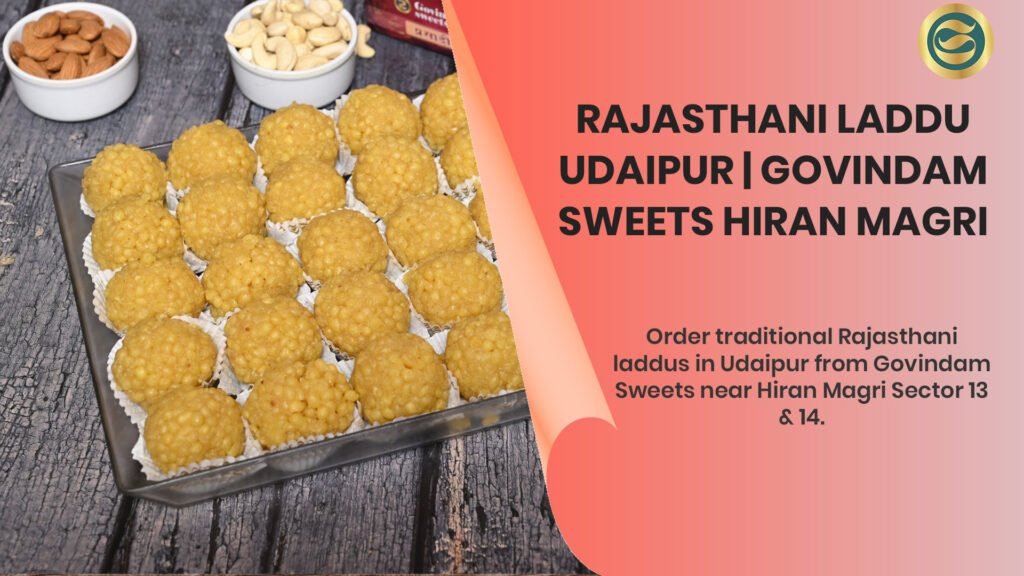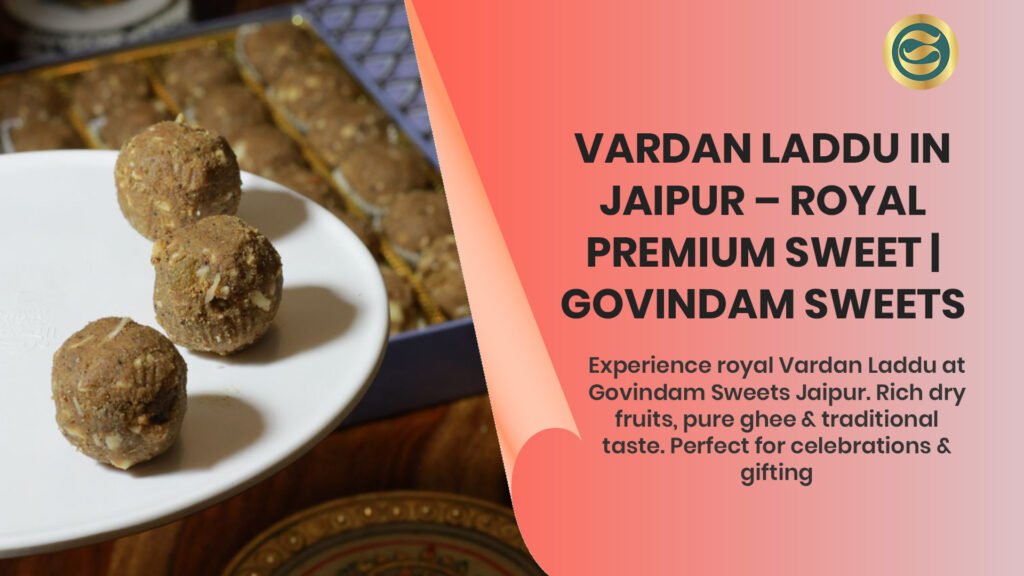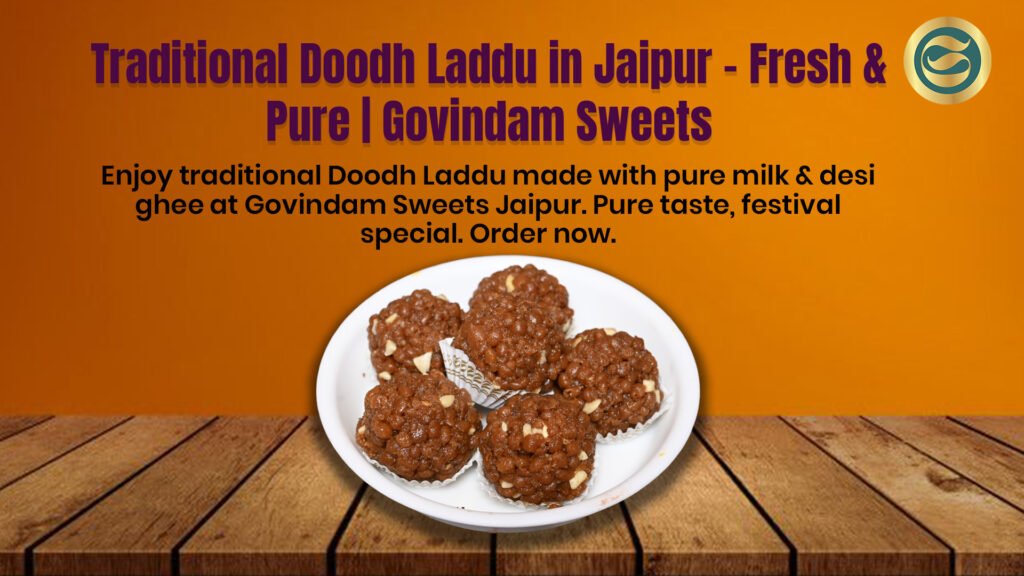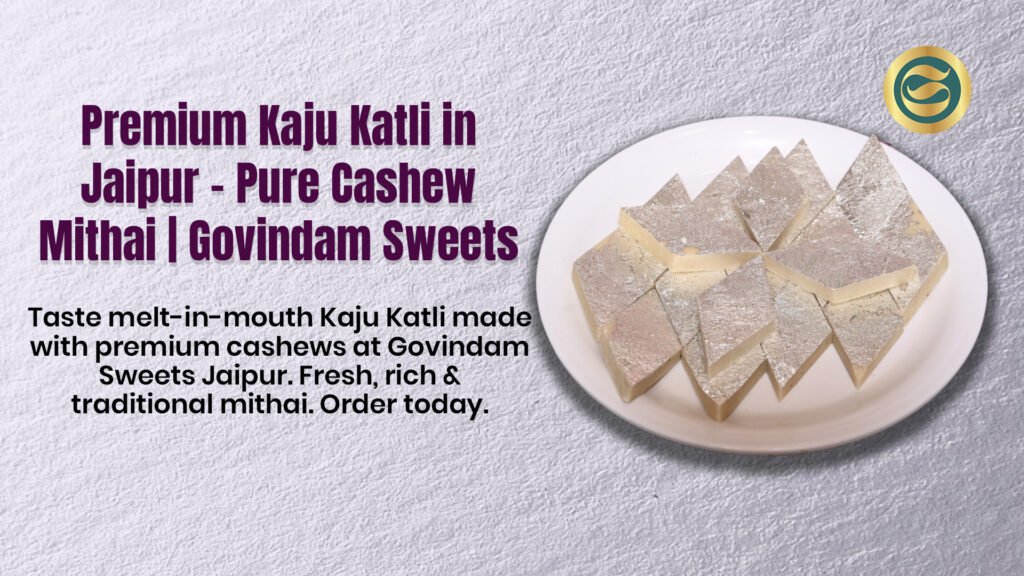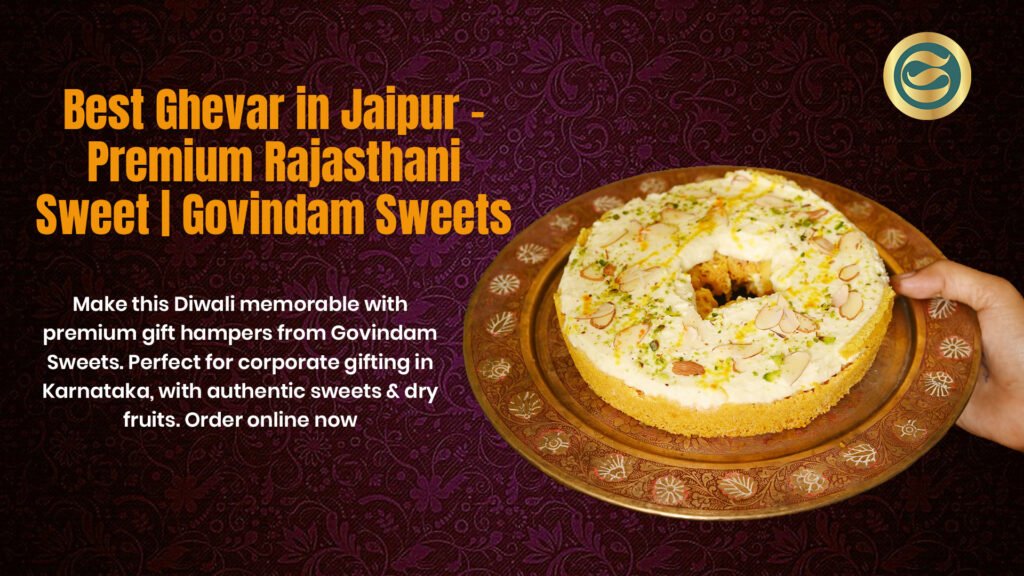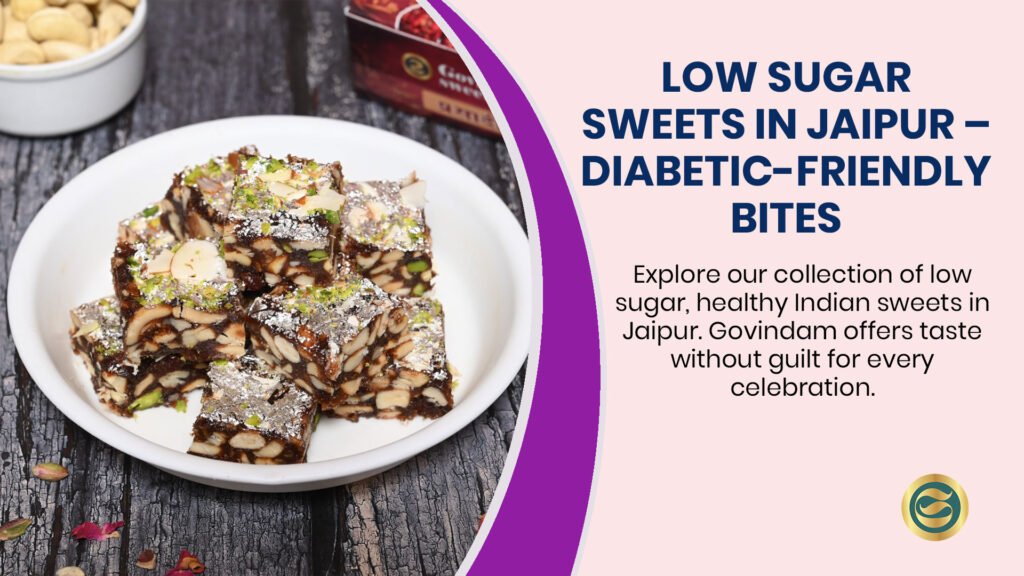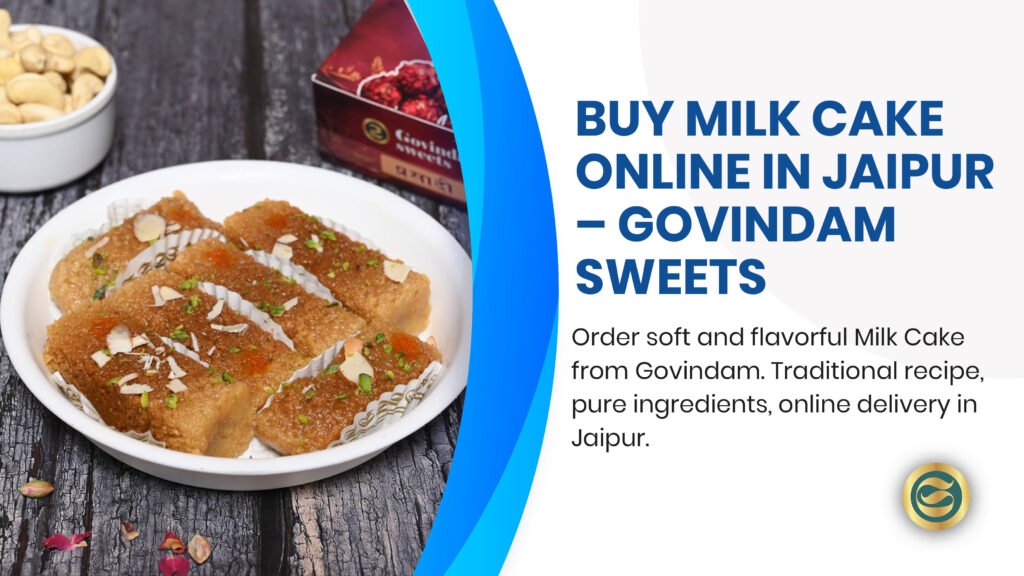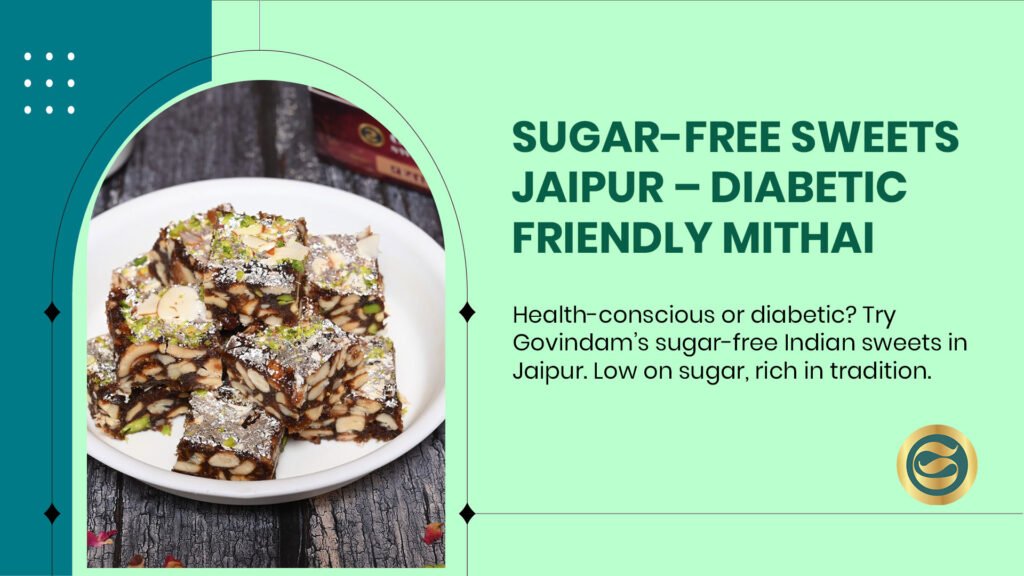
Posts
Jaipur Balwan Vardan Laddu Health Treasure Govindam Sweets Benefits

Discover Jaipur’s famous Balwan Vardan Laddu from Govindam Sweets featuring nutritious traditional ingredients, health benefits, authentic Rajasthani preparation, balanced formulation, and cultural heritage. Explore nutritional profiles, ingredient properties, traditional wisdom, wellness benefits, and why these iconic laddus represent healthy indulgence combining taste with nourishment.
जयपुर के बलवान और वरदान लड्डू खाए क्या । सेहत का खजाना | गोविंदम स्वीट्स
Jaipur’s Balwan Vardan Laddu: A Treasure of Health from Govindam Sweets
Introduction: Where Tradition Meets Wellness
Jaipur’s famous Balwan Vardan Laddu from Govindam Sweets represent remarkable fusion where traditional Rajasthani confectionery excellence meets genuine nutritional wisdom—preparations that ancestors created not merely for indulgent pleasure but as functional foods providing concentrated energy, essential nutrients, and health-supporting properties through carefully selected ingredients and time-honored formulations that Ayurvedic principles and generational experience refined across centuries. These iconic spherical sweets transcend modern dichotomy falsely opposing “tasty” and “healthy” as mutually exclusive categories, demonstrating how authentic traditional preparations properly made with quality ingredients and consumed appropriately within balanced dietary patterns contribute positively to overall wellness rather than representing pure indulgence requiring guilt or complete avoidance that contemporary health discourse sometimes wrongly suggests about all traditional sweets regardless of actual nutritional profiles and consumption contexts.
Understanding Balwan and Vardan Laddu as “सेहत का खजाना” (treasure of health/sehath ka khazana) requires appreciating both nutritional composition and cultural wisdom embedded within traditional formulations. The ingredient selection emphasizing nuts providing healthy fats and protein, ghee contributing fat-soluble vitamins and traditional medicine properties, quality flours offering complex carbohydrates and fiber, and natural sweeteners in balanced proportions creates comprehensive nutritional package delivering genuine sustenance alongside sensory satisfaction. The preparation techniques maximizing nutrient retention, the serving size traditions preventing excessive consumption, and the occasion-specific usage contexts where laddus served particular functional purposes—traveling provisions for journeys, postpartum nourishment for new mothers, winter warming foods, or celebration treats marking joyous occasions—all demonstrate sophisticated understanding that traditional food culture possessed about nutrition, moderation, and food’s multiple roles beyond mere pleasure into health support, social bonding, and cultural expression through edible heritage.
At Govindam Sweets, our signature Balwan Laddu represents decades of preparation refinement maintaining traditional formulation integrity while ensuring consistent quality through premium ingredient sourcing, expert artisan technique, and systematic quality control that modern understanding and capabilities enhance rather than replace. The name itself—”Balwan” suggesting strength and power—reflects traditional recognition that quality laddus provided genuine nutritional benefit and physical sustenance beyond empty calories, creating preparations that warriors, travelers, and working people relied upon for energy and nourishment in eras predating modern processed convenience foods lacking nutritional substance that traditional preparations inherently possessed through whole food ingredients and minimal processing preserving natural nutrient density. This comprehensive exploration examines the nutritional profiles, ingredient health properties, traditional wellness wisdom, modern scientific validation, appropriate consumption guidance, and cultural contexts revealing why Balwan and Vardan Laddu genuinely deserve recognition as health treasures when understood properly, consumed appropriately, and appreciated within comprehensive wellness frameworks that traditional cultures maintained instinctively but modern lifestyles sometimes lose requiring conscious reconnection with ancestral food wisdom that scientific nutrition increasingly validates through research confirming what experience taught generations.
Understanding Balwan Vardan Laddu
Balwan Laddu: The Strength Provider
Our signature Balwan Laddu embodies balanced traditional excellence through thoughtful ingredient composition creating preparations that satisfy taste preferences while delivering genuine nutritional value. The name “Balwan” (बलवान) literally translating to “strong” or “powerful” reflects traditional understanding that quality laddus provided strength, energy, and vitality—not mere marketing hyperbole but accurate description of concentrated nutrition that whole food ingredients and proper preparation create. The spherical format provides convenient portability that historical contexts particularly valued when preserved foods enabling travel or work away from home kitchen facilities represented practical necessity rather than mere convenience preference.
The formulation typically includes quality gram flour (besan) providing plant protein and fiber, wheat flour contributing complex carbohydrates, pure ghee delivering healthy fats and fat-soluble vitamins, jaggery or quality sugar providing energy, premium nuts including almonds and cashews adding protein and beneficial fats, and aromatic spices like cardamom contributing not just flavor but digestive properties that Ayurvedic tradition particularly values. This ingredient combination creates comprehensive nutritional profile delivering macronutrients (protein, carbohydrates, healthy fats) alongside micronutrients (vitamins, minerals) and beneficial plant compounds that modern nutrition science increasingly recognizes as important beyond basic calorie and macronutrient accounting.
Vardan Laddu: The Blessing of Nourishment
The Vardan Laddu (वरदान means “blessing” or “boon”) represents similar traditional wisdom through slightly different formulation or presentation while maintaining fundamental principle that quality traditional preparations offer genuine nourishment and health benefits when consumed appropriately. The blessing nomenclature reflects cultural understanding that good food represents divine gift and nutritious sustenance worthy of gratitude rather than guilt-inducing indulgence requiring apology—perspective shift that contemporary health culture might benefit reconsidering when vilifying all traditional preparations without distinguishing quality whole-food versions from modern ultra-processed imitations lacking nutritional substance.
The specific formulation variations between Balwan and Vardan Laddu might involve different grain bases, varying nut proportions, alternative sweetener balances, or distinct flavor profiles while maintaining shared commitment to quality ingredients, traditional preparation methods, and nutritional substance that defines authentic traditional laddus versus modern commercial versions potentially cutting corners through inferior ingredients, excessive sugar, or preparation shortcuts compromising both taste and nutritional quality that authentic traditional excellence maintains through ingredient integrity and preparation expertise.
Nutritional Composition and Health Benefits
Macronutrient Profile: Complete Nutrition
Quality laddus like Balwan and Vardan provide balanced macronutrient composition rather than being pure sugar confections as some might assume:
Complex Carbohydrates: Gram flour and wheat flour provide complex carbohydrates with fiber moderating blood sugar impact compared to refined sugar alone. The fiber content supports digestive health, promotes satiety, and contributes to cardiovascular wellness through cholesterol management and blood sugar regulation that dietary fiber’s multiple mechanisms provide.
Quality Proteins: Nuts, gram flour, and other legume components deliver plant-based protein supporting muscle maintenance, immune function, and various metabolic processes. While not complete protein sources alone, when consumed within diverse dietary patterns including dairy and other protein sources (as traditional Indian diets typically do), laddus contribute meaningfully to overall protein intake particularly in vegetarian dietary contexts where diverse plant protein sources become important.
Healthy Fats: Ghee, nuts, and seed components provide beneficial fats including monounsaturated and polyunsaturated fatty acids supporting cardiovascular health, hormone production, nutrient absorption, and cellular functions. The ghee specifically contains conjugated linoleic acid (CLA) and butyric acid that research suggests may offer health benefits beyond basic fatty acid composition, with traditional Ayurvedic medicine long attributing health properties to properly prepared ghee that modern research increasingly validates scientifically.
Energy Density: The concentrated calorie content per unit weight creates efficient energy source that historical contexts particularly valued—travelers, soldiers, workers engaging physical labor all benefited from portable high-energy foods enabling sustained activity without excessive bulk or frequent meal requirements that modern sedentary lifestyles make less practically necessary but performance contexts still appreciate through convenient dense nutrition.
Micronutrients and Beneficial Compounds
Beyond macronutrients, quality laddus deliver important vitamins, minerals, and bioactive compounds:
Vitamin E: Nuts provide substantial vitamin E offering antioxidant protection, immune support, and skin health benefits that this fat-soluble vitamin’s multiple functions deliver throughout body systems.
B-Complex Vitamins: Whole grains and legume flours contribute B vitamins supporting energy metabolism, nervous system function, and various cellular processes that this vitamin family collectively enables through different members’ specific roles.
Minerals: Calcium, magnesium, iron, zinc, and other minerals from diverse ingredient sources support bone health, oxygen transport, immune function, and countless enzymatic processes requiring mineral cofactors for proper functioning.
Antioxidants: Nuts, spices, and certain grain components provide polyphenols and other antioxidant compounds protecting against oxidative stress and inflammation that chronic disease development increasingly links to, with traditional spice usage in laddus potentially contributing meaningful antioxidant intake beyond just flavor contribution.
Essential Fatty Acids: Omega-3 and omega-6 fatty acids from nut components support brain health, anti-inflammatory processes, and cardiovascular wellness when consumed in appropriate ratios that varied traditional diets typically achieved naturally without requiring conscious omega-3 supplementation that modern dietary patterns sometimes necessitate through reduced traditional food consumption and increased processed food intake.
Traditional Wellness Wisdom and Ayurvedic Perspectives
Functional Food Traditions
Traditional Indian food culture understood concepts that modern “functional food” marketing rediscovers—that foods serve purposes beyond basic nutrition into health support, therapeutic properties, and wellness optimization. The laddu formulations reflect this wisdom through:
Warming Properties: Winter laddu consumption traditions reflect understanding that certain ingredients and preparations provide warming effects that cold weather makes particularly valuable. The ghee particularly carries warming character in Ayurvedic classification, with combined formulation creating overall warming tendency that seasonal consumption patterns appropriately matched with environmental needs.
Digestive Support: Cardamom, ginger (in some formulations), and other spices included not just for flavor but digestive properties that Ayurvedic medicine attributes to these botanicals. The recognition that digestion centrally impacts overall health in traditional medicine systems meant conscious ingredient inclusion supporting digestive wellness alongside nutritional delivery.
Energy and Vitality: Traditional understanding recognized quality laddus as energy providers and vitality supporters—not just caloric energy but comprehensive nourishment supporting overall vigor, mental clarity, and physical capacity that ancestral terminology perhaps lacked precise scientific vocabulary articulating but experience certainly validated through observed outcomes across generations and multiple cultural contexts where similar preparations appeared across diverse societies.
Postpartum Nourishment: Traditional postpartum feeding practices often emphasized laddu consumption providing dense nutrition, warming properties, and specific ingredients believed supporting recovery, lactation, and maternal wellness during vulnerable recovery period. While specific efficacy claims require careful scientific evaluation, the overall principle that nutrient-dense whole foods support recovery remains nutritionally sound even as specific traditional claims about particular ingredients warrant measured interpretation.
Dosha Balance and Constitutional Considerations
Ayurvedic constitutional theory (tridosha system) provides framework for understanding individual variation in food responses that modern personalized nutrition increasingly recognizes as important beyond one-size-fits-all dietary recommendations:
Vata Constitution: Individuals with Vata predominance (characterized by dry, cold, light qualities) traditionally advised consuming grounding, warming, moistening foods—ghee-rich laddus fitting this prescription well through warmth, density, and lubrication that Ayurvedic theory suggests countering Vata’s drying destabilizing tendencies.
Pitta Constitution: Pitta individuals (hot, sharp qualities) might require moderation with very warming preparations, though moderate laddu consumption with cooling spices or ingredients can remain appropriate within balanced dietary patterns avoiding excessive heating foods that theory suggests potentially aggravating Pitta imbalances.
Kapha Constitution: Kapha types (heavy, cool, moist qualities) traditionally advised limiting very heavy sweet foods, though lighter laddu formulations in moderation remain acceptable, particularly when balanced with Kapha-pacifying spices and consumed during appropriate times avoiding excessive Kapha accumulation that theory warns against through heavy sweet excessive consumption.
This traditional framework, while requiring translation into modern scientific terminology and validation through contemporary research methods, offers nuanced individual variation recognition that blanket dietary recommendations sometimes lack—acknowledging that same food might suit some individuals better than others based on constitutional differences that genetic, metabolic, and individual variation research increasingly confirms exist even as specific Ayurvedic classifications require ongoing scientific investigation and translation.
Ingredient-Specific Health Properties
Gram Flour (Besan): Legume Power
Chickpea flour provides numerous health benefits as primary ingredient in many traditional laddus:
Plant Protein: Substantial protein content supporting muscle maintenance and metabolic functions, particularly valuable in vegetarian dietary contexts where diverse plant protein sources become important for comprehensive amino acid profiles.
Dietary Fiber: Both soluble and insoluble fiber supporting digestive health, cholesterol management, blood sugar regulation, and satiety promotion that fiber’s multiple mechanisms deliver.
Low Glycemic Impact: Compared to refined grains, chickpea flour demonstrates lower glycemic index meaning slower blood sugar rises and falls that metabolic health benefits from through improved insulin sensitivity and reduced diabetes risk that lower glycemic dietary patterns support.
Minerals: Good source of iron, magnesium, phosphorus, and other minerals supporting various physiological functions from oxygen transport through bone health to energy metabolism.
Bioactive Compounds: Polyphenols and other phytochemicals providing antioxidant and anti-inflammatory properties that chronic disease protection increasingly links to adequate phytonutrient intake that plant-based foods uniquely provide.
Pure Ghee: Traditional Superfat
Clarified butter offers properties that traditional medicine long valued and modern research increasingly investigates:
Fat-Soluble Vitamins: A, D, E, and K absorption and delivery requiring dietary fat presence—ghee’s pure fat form particularly efficient for vitamin assimilation that these nutrients require for bodily utilization.
Butyric Acid: Short-chain fatty acid that gut bacteria produce from fiber but ghee directly provides, potentially supporting gut health, anti-inflammatory processes, and metabolic wellness that emerging research increasingly explores.
CLA (Conjugated Linoleic Acid): Grass-fed dairy especially contains this fatty acid that preliminary research suggests may offer metabolic benefits, though human studies remain limited and traditional ghee benefits may involve multiple compounds rather than single active ingredient.
High Smoke Point: While relevant for cooking rather than laddu consumption, ghee’s stability under heat prevents toxic compound formation that less stable oils might produce when heated, making ghee-fried preparations potentially safer than alternatives using unstable fats.
Ayurvedic Properties: Traditional medicine attributes various health benefits beyond modern scientific characterization—digestive kindle (agni) enhancement, tissue nourishment, toxin elimination support, and mental clarity promotion that traditional texts describe though modern validation research continues investigating mechanistic basis for observed traditional outcomes.
Nuts: Nutrient Density Champions
Almonds, cashews, pistachios, and other nuts contribute substantially to laddu nutrition:
Healthy Fats: Predominantly monounsaturated and polyunsaturated fats supporting cardiovascular health through cholesterol profile improvement, inflammation reduction, and vascular function enhancement that consistent nut consumption demonstrates across numerous population studies.
Protein and Fiber: Creating satiety and providing sustained energy rather than rapid sugar spikes and crashes that refined carbohydrates without protein and fat create.
Vitamin E: Powerful antioxidant supporting immune function, skin health, and cellular protection against oxidative damage that aging and disease processes involve.
Minerals: Magnesium, calcium, potassium, zinc, and selenium supporting multiple physiological systems from bone health through immune function to metabolic regulation.
Phytosterols: Plant compounds structurally similar to cholesterol that may help reduce cholesterol absorption, contributing to cardiovascular benefits that nut consumption consistently demonstrates.
Natural Sweeteners: Energy with Benefits
While sugar provides primarily calories, some traditional sweetener choices offer additional benefits:
Jaggery: Unrefined cane sugar retaining minerals (iron, magnesium, potassium) and some beneficial compounds that refining removes. While still primarily sugar requiring moderation, jaggery provides trace nutrients that completely refined white sugar lacks.
Honey: When used, provides not just sweetness but enzymes, antioxidants, and antimicrobial properties that traditional medicine valued. However, heating destroys some beneficial compounds, and honey’s sugar content still requires moderation despite additional beneficial components.
Dates: Some formulations incorporate dates providing fiber, potassium, and natural sweetness with lower glycemic impact than refined sugars while contributing caramel-like flavor complexity.
The traditional preference for less-refined sweeteners reflected intuitive understanding that minimally processed foods retain more nutritional value—concept that modern nutrition science strongly validates through recognizing whole foods’ superiority over isolated refined ingredients even when providing similar basic macronutrient profiles.
Modern Scientific Validation of Traditional Wisdom
Research Supporting Traditional Ingredients
Contemporary nutrition research increasingly validates traditional food wisdom:
Legume Health Benefits: Studies consistently demonstrate that regular legume consumption (including gram flour) associates with improved metabolic health, cardiovascular benefits, and chronic disease risk reduction that population studies and intervention trials repeatedly confirm.
Nut Consumption Research: Perhaps most robust evidence supporting traditional wisdom—numerous large population studies show regular moderate nut consumption strongly associates with longevity, cardiovascular health, metabolic wellness, and reduced chronic disease risk that makes nuts one of few foods with near-unanimous scientific support.
Healthy Fat Rehabilitation: Decades of low-fat dietary recommendations increasingly replaced by recognition that fat quality matters more than quantity, with traditional ghee and nut fats containing mostly beneficial unsaturated and saturated fats (yes, some saturated fat appears neutral or even beneficial contrary to older assumptions) that demonization of all fats inappropriately included in misguided simplification.
Whole Food Superiority: Mounting evidence that whole minimally-processed foods provide health benefits exceeding what isolated nutrient supplements deliver—suggesting traditional whole-food-based preparations like quality laddus offer nutritional value beyond simply summing individual nutrient contributions through synergistic interactions and food matrix effects that reductionist nutrition sometimes misses.
Limitations and Appropriate Interpretation
Scientific honesty requires acknowledging research limitations and interpretation challenges:
Correlation Versus Causation: Population studies showing benefits of traditional dietary patterns cannot definitively prove specific foods cause observed health outcomes due to confounding variables, lifestyle factors, and complex causal pathways that observational research cannot fully untangle.
Dosage and Context: Traditional moderate consumption in balanced dietary patterns differs from excessive intake as primary calorie source—health benefits observed with moderate traditional consumption don’t necessarily extrapolate to unlimited consumption or replacement of dietary diversity with single food category regardless of individual ingredient quality.
Individual Variation: Genetic differences, metabolic diversity, gut microbiome variations, and personal health contexts create individual response variations that average population results don’t capture—some individuals may tolerate and benefit from traditional preparations better than others requiring personalized assessment rather than universal recommendations.
Processing and Quality: Research validating traditional ingredients assumes quality preparation and appropriate ingredient sourcing—benefits of traditionally-prepared quality laddus don’t automatically extend to inferior commercial versions using cheap ingredients, excessive sugar, or preparation shortcuts that authentic traditional excellence avoids.
Appropriate Consumption Guidance
Portion Size and Frequency Recommendations
Quality traditional laddus deserve thoughtful consumption within balanced dietary contexts:
Appropriate Portions: Traditional serving sizes (1-2 medium laddus) provide satisfying experience and reasonable calorie intake (200-400 calories typically) without excessive consumption that larger portions might create. The spherical format naturally limits serving through discrete units unlike desserts allowing continuous consumption without clear portion definition.
Frequency Considerations: Daily consumption unnecessary and potentially excessive for most people—occasional to moderate intake (few times weekly or special occasions) aligns with traditional patterns where laddus marked celebrations, supplemented traveling provisions, or addressed specific needs rather than comprising daily staple foods that meal components provided.
Activity Level Matching: Active individuals engaging substantial physical activity can accommodate higher calorie dense foods more easily than sedentary people requiring careful energy balance—traditional contexts where laddus emerged often involved far more physical activity than modern sedentary lifestyles require nutritionally accounting for when determining appropriate intake levels.
Meal Timing: Traditional wisdom often consumed substantial sweets earlier in day when activity levels higher and metabolism more active, avoiding heavy sweet consumption before sleep when energy demands minimal and metabolic rate lower—timing strategy that modern intermittent fasting research and circadian rhythm nutrition studies increasingly validate scientifically.
Dietary Integration Strategies
Successful integration within overall wellness frameworks:
Balanced Dietary Patterns: Laddus as occasional components within diverse diets emphasizing vegetables, whole grains, legumes, fruits, and modest animal products (if non-vegetarian) creates nutritional context where traditional preparations contribute without dominating or displacing other important food groups that comprehensive nutrition requires.
Mindful Consumption: Conscious eating appreciating taste, texture, and satisfaction rather than mindless consumption while distracted creates better experience from smaller quantities through attention and appreciation that rushed inattentive eating cannot achieve regardless of quantity consumed.
Special Occasion Emphasis: Treating quality laddus as celebration foods rather than everyday casual snacks maintains traditional usage patterns and prevents habituation where special foods become routine losing both physical impact through adaptation and psychological specialness through overexposure familiarity.
Complementary Foods: Pairing with chai (tea) or warm milk as traditional practice creates beverage dilution of calorie density while providing pleasant accompaniment and social context that solitary eating lacks.
Health Conditions and Special Considerations
Diabetes Management
Diabetics can potentially enjoy quality laddus with appropriate precautions and modifications:
Portion Control: Strict limitation to small portions with careful blood glucose monitoring determining individual tolerance and metabolic response that varies between people requiring personalized assessment rather than blanket prohibitions.
Meal Context: Consuming with protein and fiber sources, never on empty stomach, helps moderate blood sugar impact through delayed absorption and reduced glycemic response that food combinations create compared to sweets consumed alone.
Lower Sugar Formulations: Some traditional recipes use less sugar or substitute partially with dates or jaggery potentially creating slightly better glycemic profiles, though all versions require moderation and monitoring regardless of specific sweetener used.
Medical Consultation: Diabetics should discuss traditional sweet consumption with healthcare providers determining appropriate inclusion within comprehensive diabetes management plans that medication, monitoring, and overall dietary patterns collectively comprise.
Weight Management Contexts
Calorie-conscious individuals can strategically incorporate quality laddus:
Caloric Budgeting: Accounting for laddu calories within daily energy targets, perhaps treating as meal replacement or reducing other meal portions compensating for sweet inclusion, maintains energy balance preventing weight gain that excessive total calories create regardless of specific food sources.
Satiety Awareness: Protein, fat, and fiber in quality laddus create better satiety than pure sugar confections might, potentially preventing subsequent overconsumption through sustained satisfaction that nutrient density provides compared to empty calories quickly metabolized leaving hunger recurring.
Psychological Benefits: Allowing modest indulgences prevents deprivation feelings that can trigger dietary rebellion and binge eating in some individuals—strategic inclusion of enjoyed foods within controlled amounts supporting long-term dietary adherence better than overly restrictive approaches that become unsustainable creating eventual abandonment.
Activity Compensation: Increasing physical activity creating caloric expenditure accommodating occasional treats maintains energy balance through output rather than just input restriction—though relying solely on exercise outrunning diet rarely succeeds as sustainable strategy given exercise’s limited calorie burning relative to dietary intake potential.
Pregnancy, Lactation, and Life Stages
Traditional usage in specific contexts:
Postpartum Tradition: Historical practice of emphasizing laddu consumption during postpartum period reflected understanding of increased nutritional needs, energy requirements, and specific beneficial ingredients supporting recovery and lactation. Modern application should balance tradition with comprehensive prenatal nutrition guidance from healthcare providers rather than relying exclusively on traditional foods without broader nutritional context.
Pregnancy Considerations: Moderate quality sweet consumption during pregnancy remains acceptable within balanced diets, though excessive sugar intake requires limitation regardless of source. The nutritious ingredients in quality laddus provide genuine nutrition rather than empty calories that some pregnancy cravings might otherwise satisfy through nutritionally-poor alternatives.
Children and Adolescents: Growing individuals with high energy needs can accommodate traditional sweets more easily than adults, though establishing healthy relationships with sweets through moderation and special occasion framing remains important preventing excessive sweet preference development or viewing sweets as routine rather than special treats.
Elderly Nutrition: Older adults sometimes face appetite challenges making nutrient-dense foods valuable—quality laddus providing concentrated nutrition in small volumes may help meet energy and nutrient needs when appetite limited, though dental considerations and individual health conditions require assessment.
Cultural Context and Food Heritage
Beyond Nutrition: Social and Emotional Dimensions
Food significance transcends pure nutrition into cultural identity, emotional satisfaction, and social bonding:
Cultural Connection: Traditional preparations maintain cultural continuity and heritage connection that food particularly facilitates across generations and geographic distances—diaspora communities particularly value traditional foods as tangible homeland connections beyond pure nutritional function.
Celebration and Joy: Foods marking joyous occasions create positive associations and memories that life satisfaction and psychological wellbeing incorporate as important dimensions often undervalued in purely reductionist nutritional frameworks treating food solely as fuel or nutrient delivery vehicle.
Social Bonding: Sharing traditional foods creates and strengthens social connections through communal consumption, gift-giving practices, and hospitality expressions that relationship quality impacts overall wellness as significantly as diet composition through stress reduction, support networks, and belonging feelings that social integration provides.
Mindful Pleasure: Guilt-free enjoyment of quality traditional preparations in appropriate contexts and quantities represents balanced healthy relationship with food avoiding both excessive restriction creating psychological distress and uncontrolled overconsumption causing physical health problems—middle path that traditional moderation wisdom exemplified before modern extremes of either demonizing all indulgences or promoting unlimited “intuitive eating” without guidance sometimes create opposing but equally problematic approaches.
Preserving Food Traditions
Cultural heritage conservation through food:
Artisan Knowledge: Supporting authentic traditional preparations maintains specialized preparation skills and recipe knowledge that industrialization and fast-food culture threaten—choosing quality traditional vendors over mass-produced alternatives helps preserve cultural knowledge and artisan livelihoods.
Ingredient Awareness: Traditional recipes using whole ingredients and minimal processing contrast with modern ultra-processed alternatives—maintaining demand for authentic preparations incentivizes quality ingredient sourcing and traditional preparation methods over cheap industrial substitutes.
Intergenerational Transmission: Families sharing traditional foods and preparation knowledge across generations maintains living heritage more effectively than museum preservation—though commercial vendors also serve crucial roles for those without family transmission opportunities or specialized preparation expertise.
Govindam’s Quality Commitment
Authentic Preparation Excellence
Our Balwan Laddu represents authentic traditional preparation maintaining quality and nutritional integrity:
Premium Ingredients: Quality gram flour, pure ghee, fresh nuts, and appropriate sweeteners creating genuine nutrition and authentic taste that inferior alternatives cannot replicate.
Traditional Methods: Patient preparation respecting traditional techniques rather than shortcuts compromising quality—proper roasting times, careful mixing, and expertise application that generations of practice refined.
Freshness Management: Appropriate production scheduling and inventory rotation ensuring optimal freshness when customers receive products—maximizing both taste quality and nutritional value that degradation compromises.
Systematic Quality Control: Batch testing, ingredient verification, and preparation monitoring ensuring consistency and standards maintenance across all production.
Transparent Communication
Our honest approach to health claims and realistic guidance:
Balanced Perspective: Acknowledging that quality laddus provide genuine nutrition while requiring appropriate moderation—avoiding both excessive health claims suggesting unlimited consumption without consequence and unnecessarily negative framing treating all sweets as purely harmful regardless of ingredient quality and consumption context.
Ingredient Disclosure: Complete transparency about ingredients, preparation methods, and nutritional information enabling informed decisions rather than vague descriptions leaving customers guessing about actual composition.
Realistic Portions: Suggesting appropriate serving sizes rather than encouraging excessive consumption despite commercial incentive to maximize sales—demonstrating customer welfare prioritization over pure profit maximization.
Cultural Education: Sharing traditional wisdom and cultural contexts enriching appreciation beyond pure nutrition into heritage understanding and appropriate traditional usage patterns that modern disconnection from food traditions sometimes loses.
Conclusion: Rediscovering Traditional Food Wisdom
Jaipur’s Balwan and Vardan Laddu genuinely deserve recognition as “सेहत का खजाना” (treasure of health) when understood properly within comprehensive wellness frameworks acknowledging that quality traditional preparations using whole food ingredients, consumed moderately in appropriate contexts, contribute positively to both physical nourishment and cultural-emotional wellbeing that health encompasses beyond reductionist biomarkers. The modern tendency toward extreme positions—either demonizing all traditional sweets as unhealthy indulgences or uncritically celebrating everything traditional as automatically healthy—both miss nuanced reality that quality, preparation methods, ingredient integrity, portion sizes, and consumption contexts all matter determining whether traditional foods support or undermine overall wellness goals.
The ancestral wisdom creating preparations like Balwan Laddu understood principles that modern nutrition science increasingly validates—that nutrient density matters, whole foods provide benefits exceeding isolated nutrients, moderate consumption within diverse dietary patterns optimizes outcomes, and food significance transcends pure biochemistry into cultural identity and psychological satisfaction that comprehensive wellness frameworks appropriately recognize. The reconnection with traditional food wisdom through thoughtful consumption of quality authentic preparations represents return to balanced sustainable relationships with food that both extreme restriction and uncontrolled indulgence abandon in opposite directions failing to achieve lasting wellness or satisfaction.
Experience the treasure of health through authentic Balwan Laddu from Govindam Sweets—discover how traditional Rajasthani preparation excellence creates nutritious satisfying sweets combining taste with genuine nourishment. Explore our complete traditional collection representing generations of expertise maintaining authentic quality that both body and soul appreciate—where ancestral wisdom meets contemporary understanding, where moderate enjoyment within balanced patterns supports rather than undermines wellness, and where every preparation reflects care, expertise, and cultural pride that genuine health treasures embody when traditional excellence receives respect, appropriate context, and mindful appreciation that both tradition and science collectively validate as path toward sustainable wellness integrating physical nourishment, cultural connection, and conscious enjoyment that comprehensive health truly requires.

